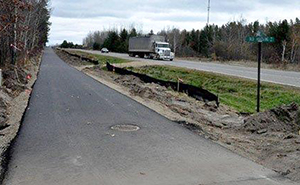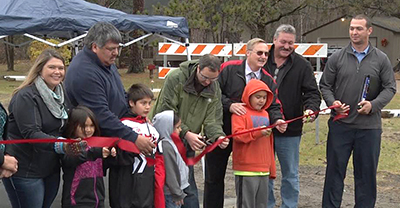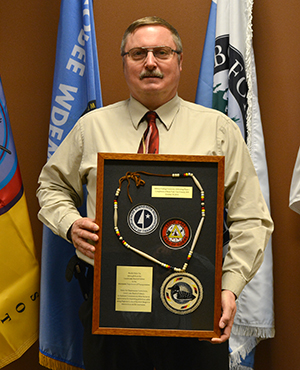By Judy Jacobs

MnDOT partnered with the Leech Lake Band of Ojibwe, Cass County and the Bureau of Indian Affairs to build a trail along Hwy 2 to make it safer for tribal members to access goods and services in their community. Photo by Aaron Fairbanks, Leech Lake Band of Ojibwe |
The small town of Bena, Minn., is located on the Leech Lake Reservation and is just a dot on the map as motorists travel between Bemidji and Grand Rapids. This small town had a big concern about safety for their members when economic development resulted in heavier volumes of traffic traveling at a much faster rate on Hwy 2 and made it difficult for members to access goods and services in their community.
In early 2014, Steve White, Leech Lake Band of Ojibwe tribal council member, contacted MnDOT to share his safety concerns about community members who needed to walk or bike on Hwy 2. Newly hired MnDOT Tribal Liaison, Ed Fairbanks, a Leech Lake Band member, knew the dangers of Hwy 2 near the Bena area and was instrumental in getting the right people together to have these discussions.
Working with White and Levi Brown, tribal director of environment and land development, Fairbanks coordinated meetings with MnDOT representatives from District 2/Bemidji, and Carol Zoff and Holly Slagle, Office of Environmental Stewardship, and road representatives from Leech Lake. This team formed a partnership that also included Cass County and the Bureau of Indian Affairs to address the need for a safer option for pedestrians and bicyclists.

(from left) Carri Jones, Leech Lake Band of Ojibwe chairwoman; Steve White, Leech Lake Band of Ojibwe tribal council; Darren Laesch, District 2; Mike Barnes, assistant commissioner of operations; Scott Bruns, Cass County Commissioner; and Amos LaDuke, Leech Lake Band of Ojibwe; joined children from the tribe for a ribbon-cutting ceremony for the Hwy 2 Bena Trail in October, 2015. Photo by Aaron Fairbanks, Leech Lake Band of Ojibwe |
“This endeavor is a shining example of a true and meaningful partnership in addressing a public safety issue facing Leech Lake Band of Ojibwe and the village of Bena,” Fairbanks said.
“Drivers do not expect to see people walking along a busy rural road such as Hwy 2,” said Craig Collison, District 2 engineer. “We wanted to work with the tribe to provide a safer option for community members.”
The Bena Bike Trail was the result of these discussions. It began with the goal to improve safety for reservation members as they traveled from the Old Housing Area to the Bena Store. Members from the Leech Lake tribe sought funding and permits from the state and federal governments since the Chippewa National Forest surrounds the town of Bena. The project was developed through a strong partnership between BIA engineering staff and Art Chase, tribal engineer.
The Bena Bike Path will be constructed in three phases. Phase 1, which extends the trail one-half mile from the Old Housing Development to the Bena Store, is complete. Mike Barnes, assistant commissioner of operations, represented MnDOT at the ribbon-cutting held in October 2015.

Mike Barnes, assistant commissioner of operations, displays a hand-beaded bolo tie and other project-related materials for the Hwy 2 Bena Trail project. Barnes accepted the gift on behalf of MnDOT from the Leech Lake Band of Ojibwe. Photo by Rich Kemp |
“This trail is incredibly important to providing safety to the people of the Leech Lake Reservation, residents of the village of Bena, and folks using the Mississippi River Trail,” Barnes said at the event, thanking Leech Lake Band of Ojibwe members for bringing their concerns to MnDOT.
“MnDOT remains committed to working with the Leech Lake Tribal Council to build and maintain a sound transportation system that supports the health of the people, environment and the economy, and helps businesses access labor, move products and prosper in our state,” he added.
Phase 2 will begin in 2017 and extend the trail approximately two miles to connect to the restaurants and surrounding businesses. Phase 3 is pending funding and is designed to complete the trail to the Winnie Dam Road.
In appreciation to MnDOT for its cooperation with the trail, Leech Lake’s Tribal Chairwoman Carri Jones presented Barnes with a hand-beaded bolo tie. The bolo, and other project-related materials, are displayed in Central Office behind the fourth floor receptionist area.
Jones said the tribe is seeing a move towards greater cooperation among government entities which, in the long run, better serves all the people of Greater Minnesota. |



